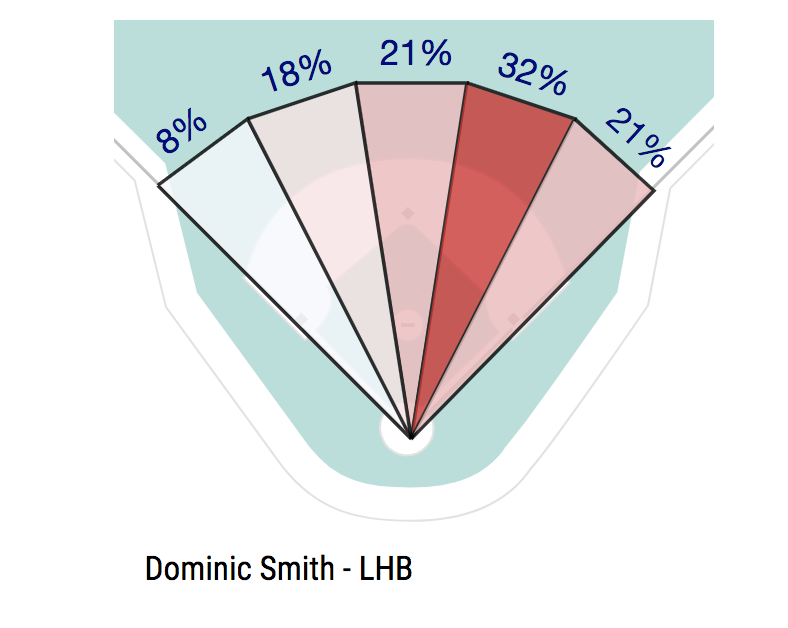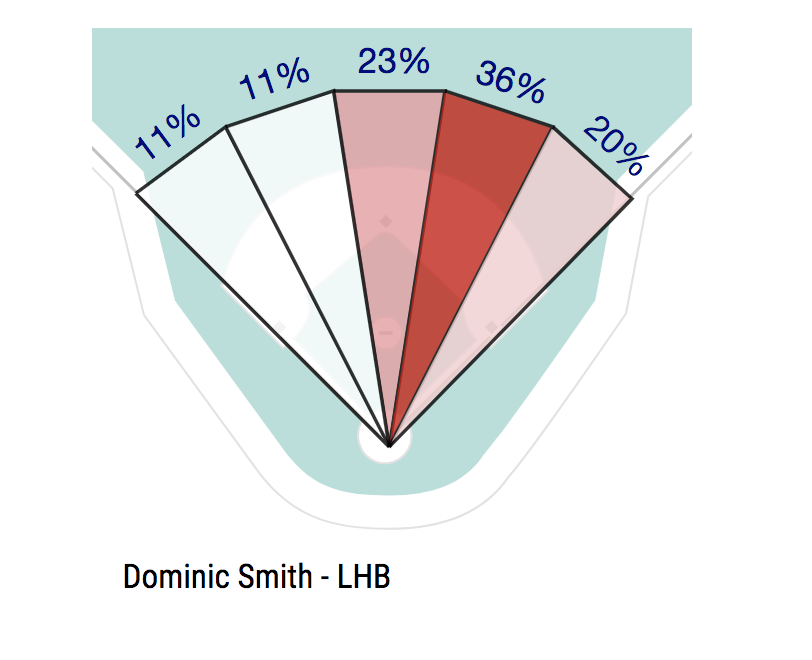When Dom Smith struggled his first year in the majors, there was constant chatter that he wasn’t performing up to expectations. We see this a lot with top prospects, they’ll gain a lot of hype, struggle in the majors and fans will dismiss any potential. Though a realist knows a top prospect dominating the minute they come up isn’t always likely; even Mike Trout struggled his first season.
Smith was called up in August of 2017, alongside shortstop Amed Rosario, for a team that was already out of the postseason race. Smith and Rosario were there to build up major league experience and were the young stars of a hopeful Mets organization. Then, in Spring Training 2019, in a fight for the starting first baseman spot, eventual 2019 NL Rookie of the Year Pete Alonso won the spot. Smith began to learn how to play left field and has shown change as of late. Before a six week injury last season, Smith had been able to produce at the plate all while he learned a completely different position from first base.
He’s one of a few Mets that have improved on their 2019 stats. Conforto is starting to develop into the player the front office always hoped to see and Robinson Cano is proving to fans that his bat speed, despite the hit by pitches on the wrist in 2019, is still there. This season, Smith has about 20 less plate appearances, but it shows that his 2020 stats are real and not exaggerated because of a shortened season. His hard hit percentage has steadily increased from 34.8% in ‘19 to 43.8% in ‘20. Smith’s increased hard hit rate is a result of his barrel percentage. Smith’s 16 barrels this season- up from 10 last year- explains his increase in power and hard hit rate. From last season to now his barrel % has almost doubled; 6.8% in ‘19 and 13.3% in ‘20. On the Baseball Savant leaderboards he’s 14th in expected stats and 23rd on exit velocity and barrels. These two stats also explain his change in pull percentage. Smith has always been a pull hitter, but this season he’s using right field and right center more instead of focusing on trying to hit to the opposite field, unless pitched there. The graph shows how he used the field in ‘19 versus this season.
Slice Chart 2019 2020 Slice Chart


The change in location is also explained by his hard hit rate %. It shows us that he’s developed more power and has the ability to drive the ball. We see this with his small decrease in launch angle: 15.1 in ‘19 and 12 in ‘20. Looking more closely, we can see that the slice chart explains his increase in pull % and drop in oppo %. In 2020 his pull % is 48.6% versus last year it was 37.6%. On the other hand, his opposite field % was 27.8% in ‘19 and 18.1% in ‘20. These two changes correlate with his hard hit percentage and barrel percentage because of his increase in power. He relies on his hitting ability to pull the ball instead of using the velocity of the pitch to hit to left field.
For the most part, Smith is being pitched to the same way he was last year. The slight change is in how many off speed pitches he sees, about a 2% increase. The graph below shows the change in the rate in which he sees off speed pitches from when he first got called up to now. You’ll see that even though the graph looks like a dramatic increase and then decreases between the years, it is only a slight difference in numbers.

Even though it was not a big jump, Smith has been able to hit offspeed pitches more efficiently. In 2019 he only got two hits off of off speed pitches in 20 at bats, both were singles. This year, Smith has seen offspeed pitches in 37 at bats, garnering 12 hits. He had no extra base hits on offspeed pitches last season and this year has five (four doubles and one home run) with an xBA of .275 and a xwOBA of .317.
It also helps that Smith is seeing consistent playing time at his top position. It’s difficult to be an offensive force when a player is focused on learning how to read a fly ball off the bat or the best paths to rob a home run. The decision to have a DH in the National League this year led analysts to assume he would DH on days when Yoenis Cespedes played left or had an off-day. But the left fielder ended up opting out of the season which meant Smith would see constant playing time. Having Smith play a secondary position, left field, it took time away from working on in game adjustments to hitting. Now, the first baseman can focus on hitting mechanics and playing consistently at first base.
Looking at Smith’s defensive stats is hard to take at face value because of the switch between the two completely different positions. A first baseman is rarely known for their defensive skills, but with Smith he also had to learn how to play left field. Yet Smith has still improved on his OAA. His OAA has seen a slight improvement from -3 in ‘18, -2 in ‘19 and -1 in ‘20. His defensive stats have slightly improved and he is playing first base more consistently.
There was once a time when Smith was in most trade rumors. Now, he’s one of the most consistent power hitters in the Mets lineup, alongside right fielder Conforto, and a needed force in a bleak MLB season.
Photo by Patrick Gorski/Icon Sportswire
